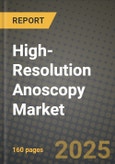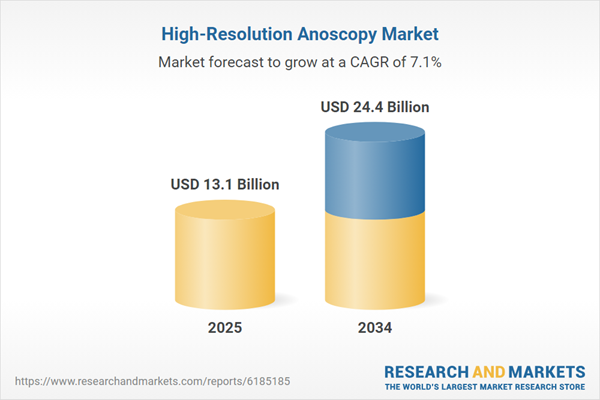The High-Resolution Anoscopy (HRA) market is experiencing steady growth, driven by increasing awareness and early detection efforts for anal intraepithelial neoplasia (AIN) and anal cancer. HRA is a specialized diagnostic procedure that allows detailed visualization of the anal canal and perianal region, helping clinicians detect precancerous and cancerous lesions effectively. The rising prevalence of human papillomavirus (HPV)-related anal lesions, especially among high-risk groups such as immunocompromised patients and men who have sex with men (MSM), has significantly increased the demand for HRA procedures. Technological advancements in anoscopic imaging and greater emphasis on preventive healthcare are further fueling adoption across diagnostic centers, hospitals, and specialty clinics. As public health initiatives increasingly focus on cancer prevention and screening, HRA has emerged as a critical tool in proactive patient care, supporting the growth trajectory of the global market.
The High-Resolution Anoscopy market witnessed notable advancements in imaging technologies, training programs for healthcare professionals, and expansion of screening initiatives across developed countries. The U.S. and select European nations continued to lead in implementing guidelines recommending HRA screening in high-risk populations, which significantly boosted procedural volumes. Improved device ergonomics and the introduction of mobile-based HRA platforms enhanced accessibility, especially in outpatient and community-based healthcare settings. Collaborations between academic institutions and medical device companies fostered innovation in image enhancement, allowing more accurate lesion identification. Additionally, the integration of artificial intelligence (AI) in interpreting HRA images emerged as a potential game-changer, reducing diagnostic variability and improving clinician confidence. Private and public funding initiatives contributed to awareness programs, with more patients opting for preventive screening, especially those with HIV or a history of abnormal cytology results, accelerating overall market momentum.
The High-Resolution Anoscopy market is poised for continued expansion, underpinned by increasing investments in healthcare infrastructure, particularly in emerging economies. The rising incidence of HPV infections and growing demand for personalized medicine are expected to fuel the adoption of HRA in broader clinical settings. Advances in AI-driven diagnostic software, coupled with cloud-based data sharing, will likely transform how HRA results are interpreted and managed across healthcare networks. Governments and NGOs are expected to expand screening coverage and subsidize procedures in underserved regions, supporting equitable access. Furthermore, ongoing research on combining HRA with molecular diagnostics could unlock new potential for early and accurate detection of malignancies. Strategic moves by key market players to diversify product offerings, improve portability, and support clinician education will reinforce market growth. As regulatory approvals for innovative technologies streamline, the HRA market is anticipated to experience accelerated adoption, improved outcomes, and broader clinical acceptance.
Key Insights: High-Resolution Anoscopy Market
- Adoption of artificial intelligence in image interpretation is enhancing diagnostic accuracy and reducing inter-observer variability in high-resolution anoscopy procedures.
- Development of portable, smartphone-compatible HRA devices is making diagnostic tools more accessible in outpatient and remote healthcare settings.
- Integration of HRA with electronic health records (EHR) is improving patient data management and facilitating longitudinal monitoring of lesion progression.
- Rising collaborations between device manufacturers and research institutions are accelerating innovation and clinical validation of new HRA technologies.
- Expanding public health screening programs targeting HPV-positive and immunocompromised individuals is driving procedural volume and awareness globally.
- Increasing prevalence of HPV-related anal intraepithelial neoplasia and anal cancer is propelling demand for early detection through HRA screening.
- Growing emphasis on preventive care and cancer screening is encouraging healthcare systems to adopt advanced anoscopic techniques for at-risk populations.
- Technological innovations in imaging, optics, and ergonomics are improving the efficiency and accuracy of high-resolution anoscopy procedures.
- Rising global awareness and government-supported initiatives are expanding access to HRA, particularly in high-incidence regions and underserved communities.
- Limited availability of trained professionals to perform and interpret HRA procedures remains a significant barrier, especially in low-resource healthcare settings.
High-Resolution Anoscopy Market Segmentation
By Product Type
- Colposcopes
- Portable Colposcope
- Hand-Held Colposcope
- Anoscopes
- Disposable Anoscope
- Reusable Anoscope
By Patient Population
- Adults
- Pediatrics
By End Use
- Hospitals
- Diagnostic Laboratories
- Specialty Clinics
Key Companies Analysed
- Philips Medical Systems Technologies Ltd.
- Olympus Corporation
- Hoya Corporation
- Steris PLC
- Allegheny Health Network
- Karl Storz SE & Co. KG
- CooperSurgical
- Ecleris S.R.L
- Pentax Medical
- Fujifilm Medical Systems
- Given Imaging
- Carl Zeiss Meditec AG
- Bovie Medical Corporation
- Hill-Rom Holdings Inc.
- Optomic
- Narang Medical Limited
- Medorah Meditek Pvt Ltd.
- Welch Allyn
- Leisegang Feinmechanik Optik GmbH
- Medimar S.A.
- DYSIS Medical
- Gynius Plus AB
- Lutech Medical
- Ottomed Endoscopy
- Seiler Garepa Pvt. Ltd.
High-Resolution Anoscopy Market Analytics
The report employs rigorous tools, including Porter’s Five Forces, value chain mapping, and scenario-based modeling, to assess supply-demand dynamics. Cross-sector influences from parent, derived, and substitute markets are evaluated to identify risks and opportunities. Trade and pricing analytics provide an up-to-date view of international flows, including leading exporters, importers, and regional price trends.Macroeconomic indicators, policy frameworks such as carbon pricing and energy security strategies, and evolving consumer behavior are considered in forecasting scenarios. Recent deal flows, partnerships, and technology innovations are incorporated to assess their impact on future market performance.
High-Resolution Anoscopy Market Competitive Intelligence
The competitive landscape is mapped through proprietary frameworks, profiling leading companies with details on business models, product portfolios, financial performance, and strategic initiatives. Key developments such as mergers & acquisitions, technology collaborations, investment inflows, and regional expansions are analyzed for their competitive impact. The report also identifies emerging players and innovative startups contributing to market disruption.Regional insights highlight the most promising investment destinations, regulatory landscapes, and evolving partnerships across energy and industrial corridors.
Countries Covered
- North America - High-Resolution Anoscopy market data and outlook to 2034
- United States
- Canada
- Mexico
- Europe - High-Resolution Anoscopy market data and outlook to 2034
- Germany
- United Kingdom
- France
- Italy
- Spain
- BeNeLux
- Russia
- Sweden
- Asia-Pacific - High-Resolution Anoscopy market data and outlook to 2034
- China
- Japan
- India
- South Korea
- Australia
- Indonesia
- Malaysia
- Vietnam
- Middle East and Africa - High-Resolution Anoscopy market data and outlook to 2034
- Saudi Arabia
- South Africa
- Iran
- UAE
- Egypt
- South and Central America - High-Resolution Anoscopy market data and outlook to 2034
- Brazil
- Argentina
- Chile
- Peru
Research Methodology
This study combines primary inputs from industry experts across the High-Resolution Anoscopy value chain with secondary data from associations, government publications, trade databases, and company disclosures. Proprietary modeling techniques, including data triangulation, statistical correlation, and scenario planning, are applied to deliver reliable market sizing and forecasting.Key Questions Addressed
- What is the current and forecast market size of the High-Resolution Anoscopy industry at global, regional, and country levels?
- Which types, applications, and technologies present the highest growth potential?
- How are supply chains adapting to geopolitical and economic shocks?
- What role do policy frameworks, trade flows, and sustainability targets play in shaping demand?
- Who are the leading players, and how are their strategies evolving in the face of global uncertainty?
- Which regional “hotspots” and customer segments will outpace the market, and what go-to-market and partnership models best support entry and expansion?
- Where are the most investable opportunities - across technology roadmaps, sustainability-linked innovation, and M&A - and what is the best segment to invest over the next 3-5 years?
Your Key Takeaways from the High-Resolution Anoscopy Market Report
- Global High-Resolution Anoscopy market size and growth projections (CAGR), 2024-2034
- Impact of Russia-Ukraine, Israel-Palestine, and Hamas conflicts on High-Resolution Anoscopy trade, costs, and supply chains
- High-Resolution Anoscopy market size, share, and outlook across 5 regions and 27 countries, 2023-2034
- High-Resolution Anoscopy market size, CAGR, and market share of key products, applications, and end-user verticals, 2023-2034
- Short- and long-term High-Resolution Anoscopy market trends, drivers, restraints, and opportunities
- Porter’s Five Forces analysis, technological developments, and High-Resolution Anoscopy supply chain analysis
- High-Resolution Anoscopy trade analysis, High-Resolution Anoscopy market price analysis, and High-Resolution Anoscopy supply/demand dynamics
- Profiles of 5 leading companies - overview, key strategies, financials, and products
- Latest High-Resolution Anoscopy market news and developments
Additional Support
With the purchase of this report, you will receive:- An updated PDF report and an MS Excel data workbook containing all market tables and figures for easy analysis.
- 7-day post-sale analyst support for clarifications and in-scope supplementary data, ensuring the deliverable aligns precisely with your requirements.
- Complimentary report update to incorporate the latest available data and the impact of recent market developments.
This product will be delivered within 1-3 business days.
Table of Contents
Companies Mentioned
- Philips Medical Systems Technologies Ltd.
- Olympus Corporation
- Hoya Corporation
- Steris PLC
- Allegheny Health Network
- Karl Storz SE & Co. KG
- CooperSurgical
- Ecleris S.R.L
- Pentax Medical
- Fujifilm Medical Systems
- Given Imaging
- Carl Zeiss Meditec AG
- Bovie Medical Corporation
- Hill-Rom Holdings Inc.
- Optomic
- Narang Medical Limited
- Medorah Meditek Pvt Ltd.
- Welch Allyn
- Leisegang Feinmechanik Optik GmbH
- Medimar S.A.
- DYSIS Medical
- Gynius Plus AB
- Lutech Medical
- Ottomed Endoscopy
- Seiler Garepa Pvt. Ltd.
Table Information
| Report Attribute | Details |
|---|---|
| No. of Pages | 160 |
| Published | October 2025 |
| Forecast Period | 2025 - 2034 |
| Estimated Market Value ( USD | $ 13.1 Billion |
| Forecasted Market Value ( USD | $ 24.4 Billion |
| Compound Annual Growth Rate | 7.1% |
| Regions Covered | Global |
| No. of Companies Mentioned | 25 |









